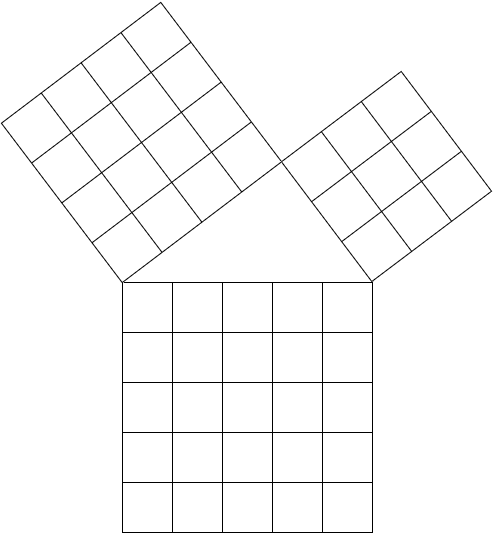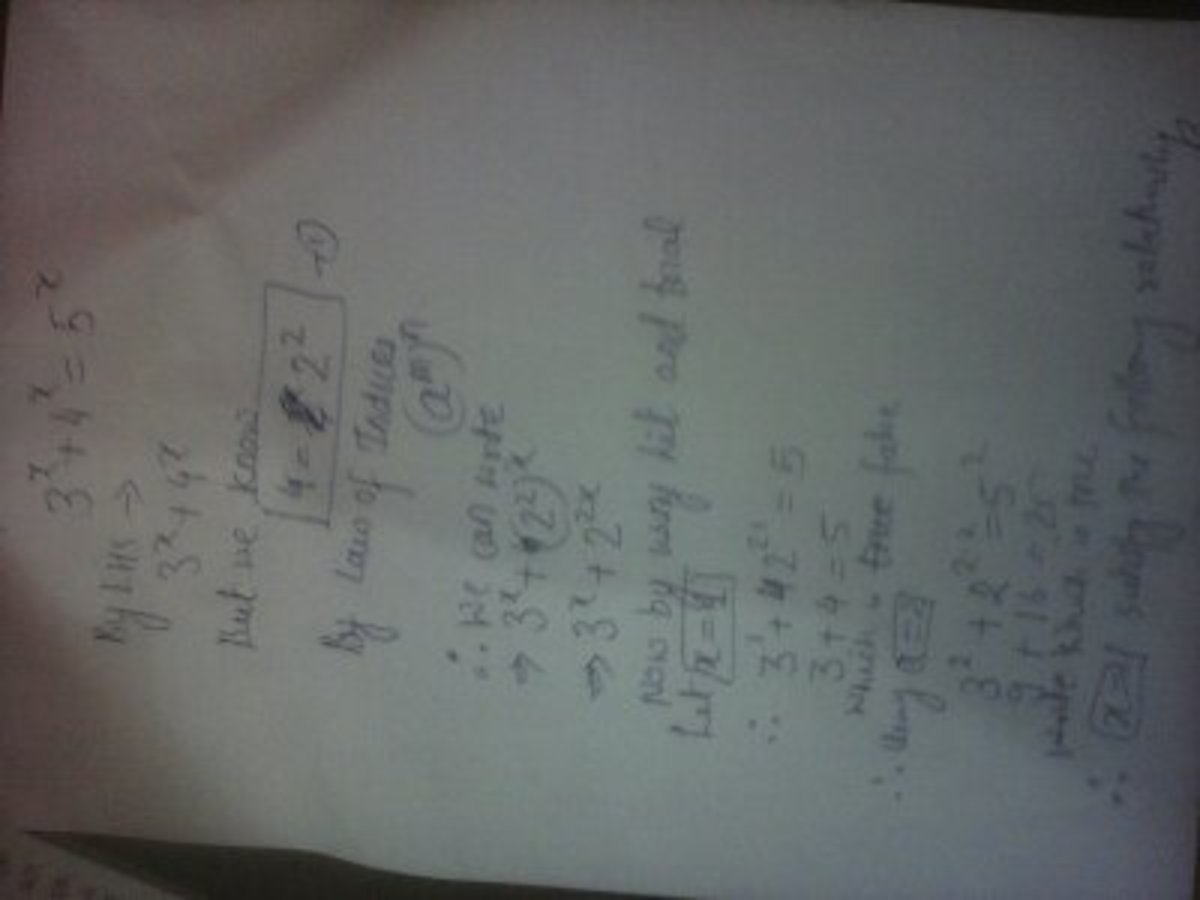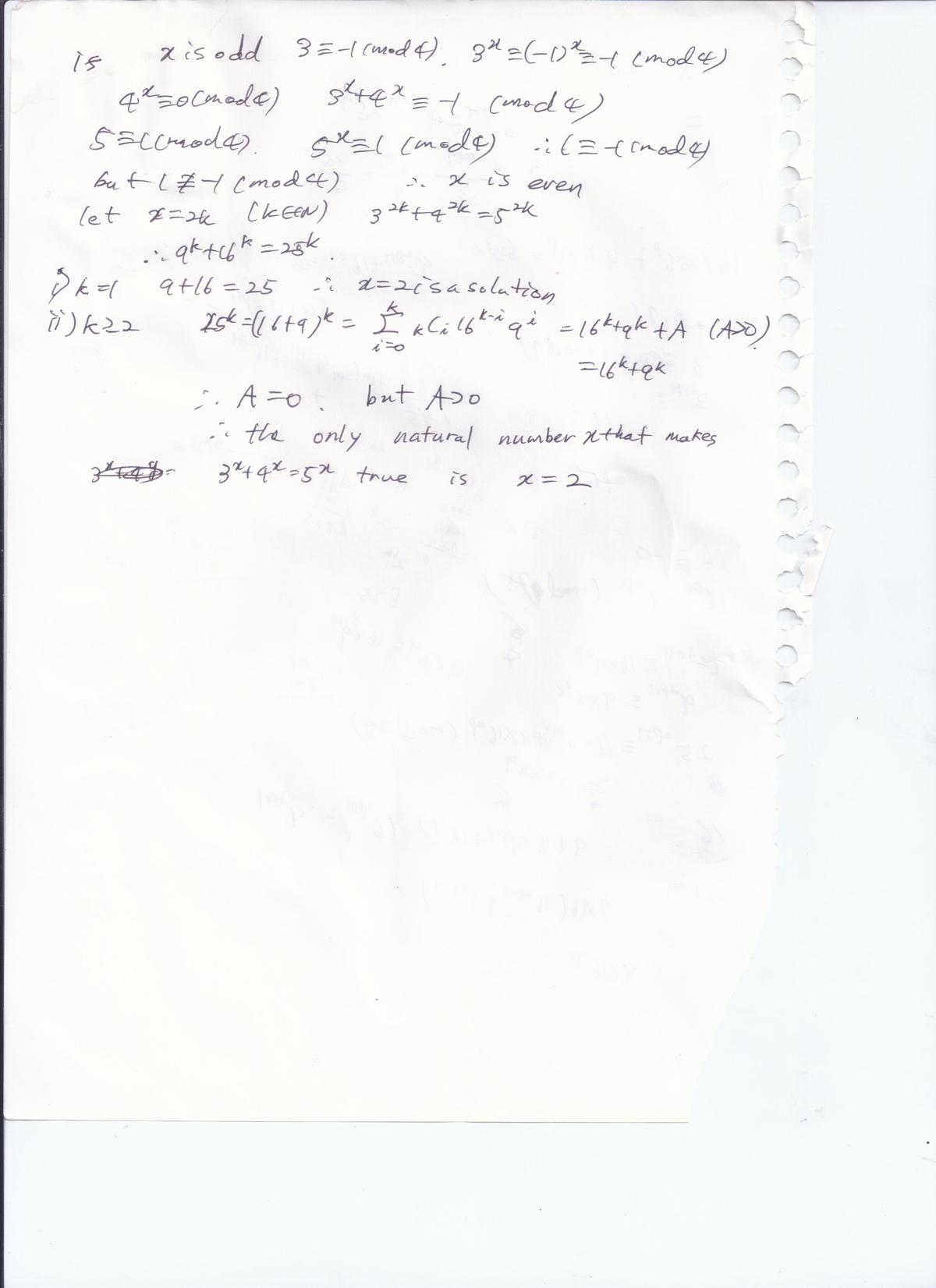A Famous Exponential
 3
x
+
4
x
=
5
x
3
x
+
4
x
=
5
x
Find the sum of all possible positive integers x so that the equation is true.
Image Credit: Wikimedia Pythagoras Theorem by Philippe Kurlapski
The answer is 2.
This section requires Javascript.
You are seeing this because something didn't load right. We suggest you, (a) try
refreshing the page, (b) enabling javascript if it is disabled on your browser and,
finally, (c)
loading the
non-javascript version of this page
. We're sorry about the hassle.
32 solutions
I will 100% agree that x=2 solves this equation. However, the question asked was NOT what value of x solves the equation, but what the sum of the values of x is. "What is the sum of value(s) of the natural number such that the equation above is true?" X does in fact equal 2, but the sum of all three values of x would be 6. Therefore the answer to this problem would be in fact 6.
3^2+4^2=5^2
2+2+2=6
Log in to reply
I agree that William Adams.The Sum of values of x is 6.
Ya I too agree with u
Agree with you
I disagree. x is the exponent for all three. The question asks for the sum of all possible values of x that satisfy the equation. That is 2. They were correct before, question is fine.
"...the sum of all POSSIBLE positive integers x..." There is only one POSSIBLE value: 2. 2 is the correct answer.
I though it was 6. It's obvious that x=2, anyone who knows the trials and tribulations of Fermat's last theorem knows that, and 2+2+2=6.
It's a very badly worded question is they think they answer is 2...
how I write answer here
3/5 is .6 but you wrote .8 how it is possible
We know that this is a Pythagorean Triple; thus, intuitively, it is easy to see that x = 2 . But, that doesn't constitute a ``proof" of this. Hence, we can exploit what we know about the above equation to confirm that there is no solution other than 2.
Let us insert the known solution, x = 2 :
5 2 + x = 4 2 + x + 3 2 + x
5 2 ⋅ 5 x = ( 4 2 ⋅ 4 x ) + ( 3 2 ⋅ 3 x )
Dividing both sides by 5 x , we obtain:
5 2 = 4 2 ⋅ ( 5 4 ) x + 3 2 ⋅ ( 5 3 ) x
Now, if x = 0 , the equality holds. But, if we allow x to increase, then the value of both summands on the right-hand-side will decrease below their squares, no longer holding. The same applies for decreasing x ; both summands increase above their squares. Thus, x must be zero in this case, leading to the conclusion that the solution is x = 2 . QED
Love this proof. Very well done and explained perfectly.
if you let x = 0 the answer will become 0 not 2
Log in to reply
Umm, nope. If x = 0, the (4/5)^x and (3/5)^x terms go to 1, meaning they vanish. Otherwise, the terms on the right side do not add to 5^2. So I'm not saying that x = 0 is a solution (which it isn't), I'm using this to prove that 2 is the only solution. Notice I say in the beginning "let us insert the known solution..." Thus x is simply an analog for proving that this equality cannot hold with any other exponent than 2. Perhaps my wording wasn't clear enough, but I hope this clarifies it for you.
Log in to reply
Natural numbers: 0, 1, 2.
Problem: 3^x + 4^x = 5^x
in basic algebra we see that solving for x means that 3 + 4 = 7, meaning it's 7^x = 5^x which can only be true if x = 0. And since 0 is a natural number, it's a valid answer.
Log in to reply
@William Anderson – You learn in US 7\8th( im not sure which) grade that zero is NOT NATURAL NUMBER! Just saying
Log in to reply
@Eva Donlon – Zero is not a natural number. Natural numbers are also called counting numbers. 1, 2, 3, ... ZERO IS A WHOLE NUMBER
@William Anderson – 0 is a whole number, natural numbers starts from 1.
@William Anderson – Well, it's wrong to generalize that 3 x + 4 x = 7 x , because it only holds if x = 1 .
You're indeed correct that x = 0 is a natural number solution (not in this problem, but 0 is a ntural number), but
3 0 + 4 0 = 5 0 , because 1 + 1 = 1 .
What I was explaining is that x is an analog to show that 2 is the only natural solution. So x = 0 was not the solution, but was rather a tool to show that the equality could not hold otherwise. The x was being ``added" to the 2 in the exponent, and when x = 0 , the equality held. Otherwise, no.
Of x will b zero then. . .and will nt zero my bro. . .there will b no solution . . .bcz power zero stands for 1 nt zero
This question can be solved in two ways :-
-
The real method i.e Fermat's Last Theorem that any 3 numbers which are related as a x + b x = c x , x can be only 1 or 2 (i.e not greater than 2)
-
The side-kick method (the silly method btw) is the Pythagoras theorem. If you are a fan of Pythagoras theorem questions , you will immediately recognize the value of x , as it is common in many questions :D .
You must give the Fermat's Last Principle
Log in to reply
Why would he? You would probably get bored to death 😂😂😹🤣😂☺️😂😹😂😜😂😉
Correct and going back to simple 1st year(13 year old) maths, 0 is not a natural number for those of you who suggested it.
Very bakwaas solution
Fermat's Last Theorem states that no three positive integers a , b , and c can satisfy the equation a n + b n = c n for any integer value of n greater than 2 .
Divide both sides by 5^x
Then the given equation can be written as
(0.6)^x + (0.8)^x = 1 ................... ( 1 )
x = 2 satisfies the given equation
i . e
(0.6)^2 + (0.8)^2 = 1
Let x be greater than 2
Then
(0.6)^x will be less than (0.6)^2 ...........(because 0.6 is a proper fraction)
also
(0.8)^x will be less than (0.8)^2............(because 0.8 is a proper fraction)
Then
(0.6)^x + (0.8)^x <(0.6)^2 + (0.8)^2
i . e
(0.6)^x + (0.8)^x < 1
which contradicts equation ( 1 )
So the given equation cannot be satisfied for x greater than 2 ...... ( I )
Now, let x be less than 2
Then
(0.6)^x will be greater than (0.6)^2 ...........(because 0.6 is a proper fraction)
Also
(0.8)^x will be greater than (0.8)^2............(because 0.8 is a proper fraction)
Then
(0.6)^x + (0.8)^x >(0.6)^2 + (0.8)^2
i . e
(0.6)^x + (0.8)^x > 1
which contradicts equation ( 1 )
So the given equation cannot be satisfied for x less than 2 ...... ( II )
From ( I ), ( II ) we get :
The solution set of the given equation is { 2 }
One of the better proofs here.
Solution is attached in the form of image

Moderator note:
This solution has been marked wrong because it has only shown that x = 2 is a root and failed to show that it has no solution for x ≥ 3 .
How do you post picture solutions?
Fermat's theorem would solve your problem
Actually it can't be solved... Cause...if x belong to natural number...this equation should be true for any natural number...but it isn't...
Log in to reply
that's not necessary. x-2=0 is a perfectly valid equation with x=2 as the solution, furthermore, 2 is the only natural number that can satisfy x-2=0.
The wording of this question is confusing: the "sum of values of x"
Try substituting x with 2&3. Simple logic will tell us the answer
It's simple Pythagoras Maths, probably the most famous example of his work with triangles, the 3,4 and 5 Triangle. The answer is 2 as when you square 3 and 4 you get 9 and 16. When added together, the answer is 25, which is 5 squared (to the power of 2),
Because of Fermat's Last Theorem, 2 is the only available answer.
By using fermat's last theorem X^n+y^n=z^n We can solve it So 3^2+4^2=5^2 So ans:2
Simple. Start assuming the values of x. Start with 2, 3²+4²=5² i.e- 9+16 which equals to 25 i.e 5². After assuming some more values you'll soon realise that 2 is the lone number that satisfies the given equation.
Because 5^x increases at an exponentially greater rate than 3^x or 4^x, we can plainly see that the only number that satisfies the equation is x=2. And for those of you saying it's 6, the question asks for the sum of all possible values of x, not sum of substitutions. Because the only possible value of x is 2, the sum is therefore the same.
Fermat's theorem. x must de 2.
This appears to be one of the Pythagorean Triads if you look at the diagram.
- Pythagoras's Theorem
- Fermat's Last Theorem.
This is Fermat's unsolved theorem, which has now been proven in a very complex mathematical paper. So while I know x=2 solves it, I also know no other values solve this.
How about -∞ as a solution for x??
The question asked for the sum of all the x's. Since x=2, sum should be 6. The answer to the question is 6 not 2
you asked for natural number... 0 is not a natural number :P
Take logs of everthing the simplify down so that x=(log(5))/(log(12))=1.943056387. So really the answer the author has put down is incorrect. But for arguments sake x=2
By substituting different values to satisfy the equation,we get answer
Fermat's last theorem can be used here It would have integral values only for x lesser than or equal to 2 . Checking all the values that are 0 , 1 , 2 , we see that x = 2 is the only solution . Therefore sum of all value(s) is 2
Is the Pitagorean theorem
3^2=9, 4^2=16, 9+16=25, Here x is replaced by 2, So, the value of X=2 .
3, 4 and 5 are pythagorean triplets,,,, H sq= P sq + B sq 5 tp 2= 3 tp2 + 4 tp2
It is a well known pythagorean triplet hence one answer is surely 2 while we know by Fermat's Theorem other natural values don't satisfy.......
Hope i'm right
Basically, we see the Pythagorean triple, 3-4-5, so 2 is indeed an answer. But, according to Fermat's Last Theorem, there are no solutions to x^n +y^n=z^n for n >2, so there are no more solutions
Simple, Pythagoras theorem. A^2+b^2=c^2
Given that 3 x + 4 x = 5 x ( 3 / 5 ) x + ( 4 / 5 ) x = 1 ( 0 . 6 ) x + ( 0 . 8 ) x = 1 ( 1 − 0 . 4 ) x + ( 1 − 0 . 2 ) x = 1 1 − 0 . 4 x + 1 − 0 . 2 x = 1 2 − 0 . 6 x = 1 1 = 0 . 6 x x = 1 . 6 7 This means that value of x should be near to 1.67 and rounding, it we get 2. Also as @Harsh Kumar said to confirm our answer the best way is Pythagorean theorem
Moderator note:
This solution has been marked wrong because ( 1 + a ) b = 1 + a b is not an algebraic identity.
it's false (1 - 0.4)^x + (1 - 0.2)^x = 1 - 0.4x + 1 - 0.2x

Divide both sides by 5 x ( 5 3 ) x + ( 5 4 ) x = 1
We see that x = 2 is satisfying this equation, but since the left hand side has both fractions possessing larger denominator (Proper fractions) , we know that for all values of x greater than 2 the solution will never be 1. (Since it is a decreasing fraction)
Thus x=2 is the only solution.
If fractions don't seem clear enough, we can visualize it using decimals
0 . 8 x + 0 . 6 x = 1 Since only 0 . 6 4 + 0 . 3 6 = 1 . 0 0 satisfy this equation, it is safe to say 2 is the only solution